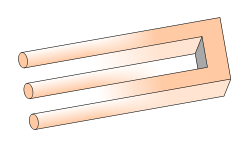Blivet
A blivet, also known as an "impossible fork," is an optical illusion and an impossible object. It appears to have three cylindrical prongs at one end which then mysteriously transform into two rectangular prongs at the other end. Often, upon first glance, the blivet looks entirely possible, but upon closer inspection quickly becomes undecipherable. Other impossible figures include the impossible cube or Penrose triangle, which also initially appear to be two dimensional representations of real objects. On closer inspection, however, such figures are found to have parts drawn from incompatible perspectives. The blivet is often used to amuse, entertain, and fascinate the viewer, revealing humankind's endless fascination with the creative and unusual.
Discovery
The blivet is often cited as having various origins. Many claim that it originated as an illustration on the cover of the March 1965 issue of Mad Magazine, from a contributer who claimed the illustration was original. It was later discovered that the figure had been previously published in several aviation, engineering, and science-fiction periodicals during May and June of the previous year. Also in 1964, D.H. Schuster published the figure in an article for the American Journal of Psychology, leading many to refer to the figure as a "Schuster Fork."[1] Some erroneously refer to artist M.C. Escher when discussing the origins of the blivet; this is most likely due to the fact that Escher is famous for works that contain similar optical illusions.
Description
The blivet is a two-dimensional drawing of what looks, at first glance, to be a three-dimensional object. It is, however, an "impossible figure"—one of a class of drawings in which two parts of the picture have been drawn in incompatible perspective. As one looks closer, one realizes that there are problems with this apparent object. When looking at one side, the object appears to have two prongs, but at the opposite side there are three.
Explanation
The blivet makes clever use of visual perspective to create the illusion. Lines that extend from one side are joined together at the opposite end to create the prongs. The longer the prongs of the fork are and the further away from each other the two sides are, the more convincing the illusion becomes.
Applications
The blivet is one of the most popular and repeated impossible figures. Numerous variations and illustrations have been made using the figure; some have even manipulated actual images to create impossible forks in real life buildings. The blivet is often grouped with other impossible figures, such as the impossible cube or Penrose triangle to add to the sense of visual ambiguity. The blivet is often used to amuse, entertain, and fascinate the viewer.
Additional Meanings of the Term
In addition to describing the impossible trident, the term "blivet" has a number of alternate meanings. During World War II, it allegedly became used to mean "ten pounds of manure in a five-pound bag" (a proverbial description of anything egregiously ugly or unmanageable); it was applied to an unmanageable situation, a crucial but substandard or damaged tool, or a self-important person. The term also has a number of meanings within the field of computer engineering, such as "a crucial piece of hardware that can't be fixed or replaced if it breaks," and "an embarrassing software bug that pops up during a customer demo," among others. The term is also used by experimental physicists and hardware engineers to refer to any random object of unknown purpose.[2]
Alternative names
- Ambiguous trident
- Devil's pitchfork
- Devil's tuning fork
- Hole location gauge
- Poiuyt
- Three-legged widget
- Three pronged blivet
- Trichotometric indicator support
- Two-pronged trident
Notes
- ↑ "Impossible Fork" The Internet Encyclopedia of Science. Retrieved October 30, 2007.
- ↑ "Blivet" Retrieved October 30, 2007.
ReferencesISBN links support NWE through referral fees
- Ernst, Bruno. Impossible Worlds: Adventures With Impossible Objects / Optical Illusions. Evergreen, 2006. ISBN 3822854107
- Fineman, Mark. The Nature of Visual Illusion. Dover Publications, 1996. ISBN 0486291057
- Marraffa, Massimo, Mario De Caro, and Francesco Ferretti. Cartographies of the Mind: Philosophy and Psychology in Intersection. Springer, 2007. ISBN 1402054432
- Salomon, David. Transformations and Projections in Computer Graphics. Springer, 2006. ISBN 1846283922
Credits
New World Encyclopedia writers and editors rewrote and completed the Wikipedia article in accordance with New World Encyclopedia standards. This article abides by terms of the Creative Commons CC-by-sa 3.0 License (CC-by-sa), which may be used and disseminated with proper attribution. Credit is due under the terms of this license that can reference both the New World Encyclopedia contributors and the selfless volunteer contributors of the Wikimedia Foundation. To cite this article click here for a list of acceptable citing formats.The history of earlier contributions by wikipedians is accessible to researchers here:
The history of this article since it was imported to New World Encyclopedia:
Note: Some restrictions may apply to use of individual images which are separately licensed.
